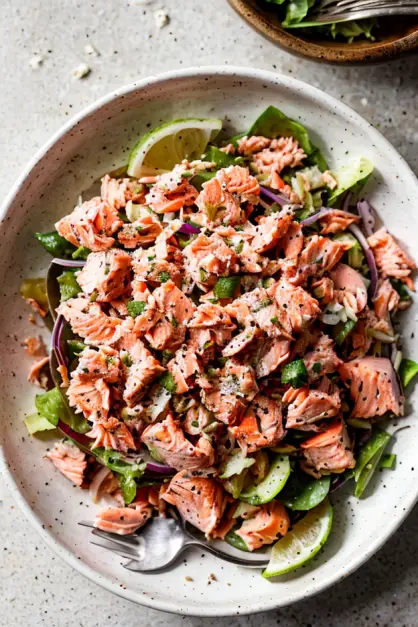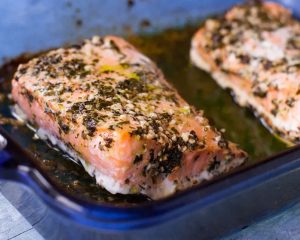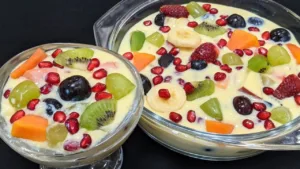Salmon salad is a delicious and nutritious dish that can be enjoyed year-round. Packed with omega-3 fatty acids, protein, and essential nutrients, salmon salad is not only good for you but also incredibly flavorful. Whether you’re looking for a light and refreshing meal or a satisfying lunch option, salmon salad is sure to hit the spot.
Introduction to Salmon Salad
Salmon salad is a versatile dish that can be customized to suit your taste preferences. It typically consists of cooked salmon, mixed greens, vegetables, and a flavorful dressing. The beauty of salmon salad lies in its simplicity and adaptability. You can use grilled, baked, or poached salmon, and pair it with a variety of ingredients to create a dish that is both delicious and nutritious.
Incorporating salmon into your diet is highly beneficial due to its rich nutritional profile. Salmon is an excellent source of protein, omega-3 fatty acids, vitamins, and minerals. Consuming salmon regularly has been linked to numerous health benefits, including improved heart health, brain function, and reduced inflammation.
Ingredients for Salmon Salad
To make a basic salmon salad, you will need the following ingredients:
- Fresh salmon fillets
- Mixed salad greens (such as spinach, arugula, or kale)
- Cherry tomatoes
- Cucumber
- Red onion
- Avocado
- Lemon
- Olive oil
- Salt and pepper
These ingredients form the foundation of a simple yet delicious salmon salad. However, feel free to get creative and add your favorite ingredients to customize the salad to your liking. You can include additional vegetables, fruits, nuts, or seeds to enhance the flavor and texture of the salad.
Preparation Techniques
Preparing salmon salad is quick and easy, making it perfect for busy weeknights or lazy weekends. Here’s how to make a basic salmon salad:
- Cook the salmon: Start by seasoning the salmon fillets with salt, pepper, and a squeeze of lemon juice. Grill, bake, or poach the salmon until it is cooked through and flakes easily with a fork. Allow the salmon to cool slightly before assembling the salad.
- Prepare the vegetables: While the salmon is cooking, wash and chop the salad greens, cherry tomatoes, cucumber, red onion, and avocado. You can also add any additional vegetables or fruits of your choice.
- Assemble the salad: Arrange the mixed greens on a serving platter or individual plates. Top with the cooked salmon, cherry tomatoes, cucumber, red onion, and avocado.
- Make the dressing: In a small bowl, whisk together olive oil, lemon juice, salt, and pepper to make a simple dressing. Drizzle the dressing over the salad just before serving.
- Serve and enjoy: Garnish the salad with fresh herbs or a sprinkle of toasted nuts or seeds, if desired. Serve immediately and enjoy!
Flavor Enhancements
To enhance the flavor of your salmon salad, consider incorporating the following ingredients:
- Fresh herbs such as dill, parsley, or cilantro
- Spices such as paprika, cumin, or chili powder
- Creamy dressings such as tzatziki, ranch, or tahini
- Citrus fruits such as lemon, lime, or orange
- Nuts and seeds such as almonds, walnuts, or sunflower seeds
These flavor enhancers can take your salmon salad to the next level, adding depth and complexity to the dish.
Customization Options
One of the best things about salmon salad is its versatility. There are countless ways to customize the dish to suit your taste preferences and dietary needs. Here are some ideas for customizing your salmon salad:
- Add extra vegetables: Experiment with different vegetables such as bell peppers, carrots, or radishes to add color and texture to the salad.
- Incorporate fruits: For a touch of sweetness, try adding fruits such as strawberries, blueberries, or mango to the salad.
- Include grains: Boost the fiber content of the salad by adding cooked grains such as quinoa, farro, or brown rice.
- Swap the protein: If you’re not a fan of salmon, you can easily substitute it with grilled chicken, shrimp, tofu, or chickpeas.
- Play with dressings: Change up the flavor profile of the salad by using different dressings such as balsamic vinaigrette, honey mustard, or sesame ginger.
The possibilities are endless when it comes to customizing your salmon salad. Get creative and have fun experimenting with different ingredients and flavor combinations!
Presentation Ideas
When it comes to presenting your salmon salad, the key is to make it look as appetizing as it tastes. Here are some presentation ideas to consider:
- Layered salad: Arrange the ingredients in layers on a platter or in a glass bowl for a visually stunning presentation.
- Garnish with herbs: Sprinkle fresh herbs such as dill, parsley, or chives over the top of the salad for a pop of color and flavor.
- Add texture: Incorporate crunchy elements such as toasted nuts, seeds, or croutons to add texture and interest to the salad.
- Serve in individual portions: For a more elegant presentation, serve the salad in individual bowls or on small plates garnished with a lemon wedge.
- Use decorative serving ware: Serve the salad in a decorative salad bowl or on a stylish serving platter to elevate the presentation.
By paying attention to the presentation of your salmon salad, you can enhance the dining experience and impress your guests with your culinary skills.
Storage and Leftovers
If you have leftover salmon salad, you can store it in an airtight container in the refrigerator for up to three days. To maintain freshness, keep the salad and dressing separate until ready to serve. When ready to enjoy, simply toss the salad with the dressing and any additional toppings.
It’s important to note that the texture of the salad may change slightly after being refrigerated, as the vegetables may become softer and the flavors may intensify. However, leftover salmon salad can still be delicious and satisfying, making it a convenient option for quick and easy meals.
Troubleshooting Tips
Encountering issues with your salmon salad? Here are some troubleshooting tips to help you overcome common challenges:
- Overcooked salmon: If your salmon is dry or tough, it may have been overcooked. To prevent this, be sure to cook the salmon just until it is opaque and flakes easily with a fork.
- Bland flavor: If your salad lacks flavor, try adjusting the seasoning by adding more salt, pepper, or lemon juice. You can also experiment with different herbs, spices, and dressings to enhance the flavor profile.
- Watery dressing: If your dressing is too thin or watery, try adding a spoonful of mayonnaise or Greek yogurt to thicken it. You can also whisk in a bit of cornstarch or flour to help emulsify the dressing and prevent separation.
- Soggy vegetables: If your salad greens are wilted or soggy, it may be due to excess moisture. Be sure to pat the vegetables dry before assembling the salad, and avoid overdressing the salad until just before serving.
- Leftover storage: When storing leftover salmon salad, be sure to keep it refrigerated in an airtight container to prevent spoilage. If the salad seems dry after refrigeration, you can refresh it by adding a bit more dressing or a squeeze of lemon juice before serving.
By following these troubleshooting tips, you can overcome any challenges and ensure that your salmon salad turns out delicious every time.
Conclusion
In conclusion, salmon salad is a versatile and delicious dish that can be enjoyed in a variety of ways. Whether you’re looking for a light and healthy lunch option or a satisfying dinner entree, salmon salad is sure to please. With its rich nutritional profile, customizable ingredients, and endless flavor possibilities, salmon salad is a must-try for seafood lovers and salad enthusiasts alike.
So why not whip up a batch of salmon salad today? Get creative in the kitchen, experiment with different ingredients and flavors, and enjoy a nutritious and delicious meal that’s sure to satisfy your taste buds.
FAQs About Salmon Salad
- How long can I store leftover salmon salad in the refrigerator?
- Leftover salmon salad can be stored in the refrigerator for up to three days in an airtight container.
- Can I use canned salmon instead of fresh for the salad?
- Yes, canned salmon can be used as a convenient alternative to fresh salmon in the salad.
- Is it safe to eat leftover salmon salad if it has been left out at room temperature?
- It is not recommended to eat leftover salmon salad that has been left out at room temperature for more than two hours, as it may become unsafe to consume.
- Can I freeze salmon salad for later consumption?
- While it is possible to freeze salmon salad, the texture of the vegetables may become mushy upon thawing. It is best to enjoy salmon salad fresh for optimal flavor and texture.
- What are some alternative protein options for salmon salad?
- If you prefer not to use salmon, you can substitute it with grilled chicken, shrimp, tofu, or chickpeas for a vegetarian option.
By addressing these common questions, you can ensure a successful salmon salad experience for yourself and others.





